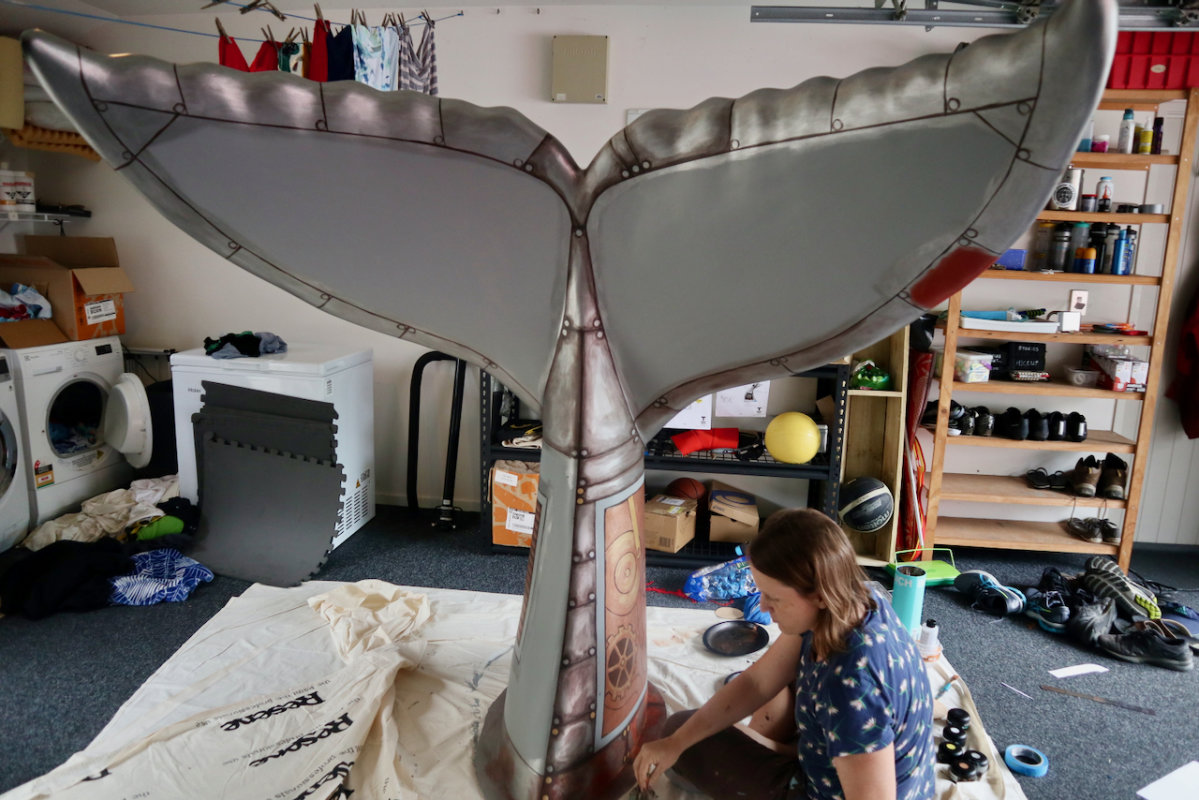Diving into Whale Tales Art with Amy van der Loo

Have you seen the giant steampunk-inspired whale tail out front of MOTAT's Great North Road site? Created by Tāmaki Makaurau artist Amy van der Loo, the tail is called 'Whale Tail 2121' and speaks to the future of our moana if we don't tackle climate change with science.
MOTAT spoke to Amy to get the lowdown on how the opportunity came about and what her process looked like from start to finish.
Tell me a bit about yourself!
I live in Browns Bay, Auckland, and work as clinical editor for New Zealand Doctor Rata Aotearoa and Pharmacy Today, two newspapers for healthcare professionals. I grew up in the deep south (Invercargill), before gradually making my way up the country, with a 10-year stint in the US thrown in. I’ve had a few different passions ebb and flow over the years, including dressage (an equestrian sport) and mountain biking, but I always come back to art.

How did you get started as an artist?
My mum is a talented artist and was an art teacher, so I was surrounded by opportunities to try different art techniques as a child. I took art in high school, but no further, as I was more scientifically minded at the time. However, creating artistic things has remained an important hobby for me.
What mediums do you work with?
I usually paint with acrylics on canvas or board, but also enjoy playing with paper, mixed media and stamp carving. Most of my art is given to family and friends. I have made papier-mâché clocks for most of my family, and I recently became interested in the cyanotype process, which is a lot of fun.
How did the whale tail process start, did WWF reach out to you?
During COVID-19 lockdown #1 in 2020, I came across the invitation to submit a design to Whale Tales and thought it would be a good lockdown activity for me and my two kids. I entered my design, and it was a nice surprise to hear from WWF 18 months later when they let me know my design had been selected by a sponsor.
When did you begin working on it?
I had just two weeks in early December 2021 to paint my tail. Since I work during the day, I got up early to paint most mornings. I couldn’t paint much at night because it was too dark in my garage. I also put in a couple of long weekends to get it finished in time.

What was the process for the whale tail from beginning to end?
First, the tail needed a light sand and a couple of coats of primer, then two coats of grey base colour to go under the silver metallic paint. After that, I applied two coats of silver over most of the tail, although I worked in sections initially, while I worked out how to get the look I was after.
To translate my design to the large sculpture, I marked it out with painter’s tape so the lines between the “panels” would be straight. I ran down each piece of tape with a line of black/brown paint. I also used sticky dots to mask off the “rivets” and painted around those with the same dark paint mix.
After removing the tape and dots, I worked on ageing the metal. Working in the heat proved to be a challenge as the paint dried so quickly. I had to use a watery mix of dark paint, which I smeared on and then rubbed about and wiped off with a piece of rag. Sometimes, I had to give a section a few goes to get it right. I also painted each rivet in gold, with highlights added.
Then came all the details. I started by adding more layers of paint to get the rust effect around the bottom of the tail. For the labels, I decided stencils were the way to go, so I designed them on paper and cut them out. I used a sponge to blot paint through the holes in the paper, so the text and images didn’t end up too new and crisp.
I used similar techniques for the open hatch on the side, which shows the internal workings of the machine – I used paper stencils and painter’s tape to mark out the different parts. Then I painted them with the beautiful copper and gold metallic paints, and added shading and highlights. I lost count of how many layers of paint some areas had.
What inspired your tail and why did you choose to go with a dystopian future?
I think I can trace my idea back to a picture book I enjoyed as a young child called Henry’s Quest by Graham Oakley. It was about a young man in a post-apocalyptic world who went on a quest to find petrol. My dad also raised me well on movies such as Mad Max. Ever since then, I’ve loved post-apocalyptic stories and the idea that discarded objects can be valued again and given a new life as something different.
When I read the Whale Tales artist’s brief about the endangered Bryde’s whale, I immediately imagined a world 100 years in the future, in which whales are extinct and inventors repurpose what they can to create mechanical whales. It’s a tale of climate change and environmental degradation, which is a bit dark and dire, so I incorporated some fun with the food labels. These show what we might be eating in the year 2121, if not much sooner – cricket crackers, pork grown in petri dishes in the lab, and 3D-printed tomatoes and strawberries!
What did you use to design and paint the tail?
I designed the tail on paper in pen and coloured pencil. I enjoyed designing all the little details, but regretted that a bit when it came to painting them on the 1.8m high tail. I got tired of painting rivets! We were supplied with Resene test pots in the colours we needed. It was a big job, but the Resene paints were nice to work with and behaved a lot like the acrylics I’m used to.

How was it picked up from you once completed?
I live at the bottom of a steep driveway. A man walked down from his truck, picked up the tail, literally threw it over his shoulder and carried it up the drive. I got the impression he had done this a few times before.
What are your thoughts on the Kaupapa behind WWF’s Whale Tales 2022 Art Trail?
We are blessed with sparkling blue seas in Aotearoa, so I think their ill health is often overlooked, or perhaps people believe the oceans are so big that they can handle a bit of pollution, plastic, sand-mining, over-fishing, etc. In fact, we rely on healthy oceans for our survival, but we have not been looking after them very well. WWF’s Whale Tales is raising awareness of the plight of New Zealand’s oceans, and that is a really important issue for all of us on this little island nation.
How do you feel about MOTAT being neighbours with your whale tale?
I think it’s a great location for my whale tail, not only because my tail is supposed to look like a mechanical invention. MOTAT is full of hope for a brighter future than the one represented by my tail ��– MOTAT shows us the power of technology and how it can be put to good use.
What advice do you have for tamariki looking to innovate and support Papatūānuku and the natural environment?
Remember that everything you do has an impact on our world, so try to make those impacts as positive as possible. Don’t get overwhelmed by the huge issues we face – even small things can help, including spreading the word to friends and whānau. We all have a part to play in protecting our planet.
Fun Quick Fire:
Oh dear, I’m terrible at making quick decisions…
1. Pie or sausage roll? Pie.
2. Book or movie? Movies at the moment, because I do so much reading for work.
3. Music or podcasts? It depends what mood I’m in and whether I can actively listen.
4. Summer or winter? Summer, although winters in Colorado were pretty amazing.
Make sure to head to the Whale Tales 2022 Art Trail website and take a trip to your local tales before it finishes on 18 April. If you see any you love, they will be auctioned off with the proceeds helping to fund WWF-New Zealand's vital work to protect Aotearoa's marine environment and its taonga species, including the Bryde's whale (the inspiration for the whole trail!)
Tag us in your photos @motatnz on Facebook and Instagram and don't forget to use #whaletales2022.
Story by Makayla Wallace-Tidd, Communications Coordinator, MOTAT
Citation:
Wallace-Tidd, Makayla, 2022. Diving into Whale Tales Art with Amy van der Loo. MOTAT Museum of Transport and Technology. Published: 7 March 2022. URL: https://www.motat.nz/collections-and-stories/diving-into-whale-tales-art-with-amy-van-der-loo